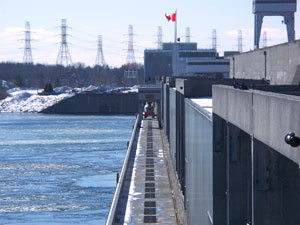After a nearly two-week delay, water levels normalized enough this spring along the Montreal to Lake Ontario (MLO) section of the St. Lawrence Seaway to allow the navigation season to open. Lost time and limitations imposed on transits, however, meant lost money for ship operators.
Requiring tug assists, reduced speeds, less cargo and other restrictions meant millions of dollars in additional operating costs. Such measures and delaying the season for 12 days were prompted by above-normal precipitation that resulted in record-high water levels — and thus fast-moving currents that make navigation more challenging — across the Great Lakes. This was an especially devastating problem in 2017 and 2019.
Shipping interests say they recognize the need to ensure safe navigation, but that the season delay to April 1 was a poorly timed hit. More than 100 expected ship transits supporting over $80 million in economic activity did not happen, according to the Chamber of Marine Commerce, an Ottawa-based association that represents ship operators, ports, marine suppliers and marine transport customers operating along the Seaway.
Record flooding has led to calls by residential groups and politicians for the International Lake Ontario-St. Lawrence River Board to increase the outflow at the Moses-Saunders Power Dam, the only point along the Seaway where water levels can be manually controlled. But even competing interests acknowledge that the dam, which straddles the border between Massena, N.Y., and Cornwall, Ontario, is a limited tool.
In theory, increasing outflow can help lower the level of Lake Ontario to alleviate flooding. But the reality is that the lake can only be lowered a few centimeters before it risks draining upstream municipal water supplies, flooding downstream communities around Montreal, and creating dangerously fast-moving currents.
The river board considered keeping the outflow levels higher, delaying the season opening until April 15, a move the Chamber of Marine Commerce and others successfully rallied against.
“Analysis demonstrated delaying the shipping opening another two weeks would have accelerated economic activity losses in the U.S. and Canada to $445 million (USD $326 million) and adversely affected over 5,000 jobs,” said Bruce Burrows, the chamber’s president and CEO.
By the end of May, shipping regulations on the waterway had returned to normal.
“So, we are expecting normal navigation conditions on the St. Lawrence Seaway for the time being,” Burrows said. “But this was really achieved due to more favorable dry weather conditions than anything else.”
Mother Nature — including the amount of precipitation, evaporation and ice formation — is what primarily determines water levels on the pivotal Seaway, stakeholders agree.
“The science clearly demonstrates that one single dam is not the solution to high water levels and flooding,” Burrows said. “We have been advocating to all levels of government in the U.S. and Canada that we need more holistic, effective solutions that don’t damage other parts of the economy for the sake of political expediency.”
The chamber’s recommendations include investing in technology that better informs commercial shipping interests when outflows are high, urging the International Joint Commission (IJC) and governments to partner with scientific and engineering experts to study options, and consulting with stakeholders.
Quebec has set a good example for other jurisdictions by taking steps to identify and map floodplains and limit construction in these zones. It also has implemented buy-back programs for residents with property in flood zones. Another example would be looking at ways to shore up critical infrastructure and protect the shoreline from erosion. And some scientific experts have suggested restoring wetlands as a natural way to buffer the effects of flooding.
Moderating competing Seaway interests has always been tricky, said David Fay, engineering adviser for the IJC, which sets rules for the Moses-Saunders Power Dam. The interests of officials who manage the waterway may not always align with those of the commission, “but we try to understand everyone and their needs,” he said.
It’s always a delicate situation balancing safety and costs, said Chad Allen, director of marine operations for the Shipping Federation of Canada, which advocates for the country’s ocean shipping industry.
“Our members understand it is a balancing act,” he said. “Having mitigation measures in place means an additional cost to operate, but at least we’re still moving. We managed to operate last year in extreme conditions and really pushed the limits of safety. I’m not sure we want to go back down that road again.”
Restrictions didn’t spell economic pain for all parties this spring. High water meant some ships were able to load deeper than usual, said James Weakley, president of the Lake Carriers’ Association, which represents U.S.-flag operators on the Great Lakes. He said output levels at Moses-Saunders had no impact on LCA members.
“Our ships primarily stay in the upper Great Lakes, seldom sailing into Lake Ontario and the St. Lawrence Seaway,” he said. “If anything, the delayed opening of the Seaway on April 1 had an indirect benefit. It put less of a strain on the limited Coast Guard icebreaking assets on the Great Lakes.”

